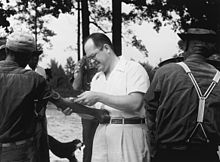Tuskegee syphilis experiment
The Tuskegee Syphilis Study was conducted from 1932 to 1972 in the Tuskegee area of Alabama by the United States Public Health Service (PHS), an agency of the United States Department of Health and Human Services, under the direction of physician John Charles Cutler. This study examined the consequences of untreated syphilis infections, a sexually transmitted disease that is often chronic, in humans. 399 African American sharecroppers - a type of sharecropper - infected with syphilis were examined as part of the study. 200 other people who were considered non-syphilis-infected were included in the studies as a control group. The subjects were largely poor and could not read or write.
This study is known for its inhumane conduct: its purpose was to observe the natural course of syphilis disease. The study was not stopped when effective syphilis drugs became available. The trial participants were not given the opportunity to give informed consent. They were also not told about a syphilis diagnosis. Instead, they were told that they had "bad blood" and that they would receive free treatment. They would also receive free rides to the clinic, a hot meal daily, and $50 for burial in case of death.
By chance, Peter Buxtun, an epidemiologist working at the PHS, learned of the study in the fall of 1965. Buxtun tried to get his agency to stop the experiment, but was unable to get anything done there, just as he had been unable to get anything done with the U.S. Centers for Disease Control in 1966. Everywhere he was assured that the project would continue until the last patient died. Three years later he was still told by the CDC that they had no moral objections. As a result, in 1972 he inaugurated journalist Jean Heller, who brought attention to the study with a report in the Washington Evening Star on July 25, 1972. At that point, 74 of the people who had participated in the beginning of the study were still alive. Under public pressure, the PHS convened an investigating committee, which after three months decided to stop the study. The lawyer Fred Gray, who had already represented Martin Luther King in court, finally obtained compensation of nine million US dollars for the survivors of the study.
In another of Cutler's studies in Guatemala from 1946 to 1948, prisoners, soldiers and persons suffering from mental disabilities were infected with syphilis. The purpose was to see if penicillin could cure syphilis. In 2010, the US government apologized for these experiments.

Blood collection as part of the Tuskegee syphilis study
Questions and Answers
Q: What was the Tuskegee Syphilis Experiment?
A: The Tuskegee Syphilis Experiment was a clinical study conducted by the United States Public Health Service between 1932 and 1972.
Q: What was the goal of the Tuskegee Syphilis Experiment?
A: The goal of the Tuskegee Syphilis Experiment was to study how syphilis progressed if it was not treated.
Q: Who were the subjects of the Tuskegee Syphilis Experiment?
A: The subjects of the Tuskegee Syphilis Experiment were poor African American sharecroppers.
Q: What did the test subjects of the Tuskegee Syphilis Experiment believe they were receiving?
A: The test subjects of the Tuskegee Syphilis Experiment believed that they were receiving free health care from the U.S. government.
Q: Were the test subjects of the Tuskegee Syphilis Experiment informed that they had syphilis?
A: No, none of the men being studied were told that they had syphilis.
Q: When was the cure for syphilis discovered?
A: The cure for syphilis, penicillin, was discovered in the 1940s.
Q: Were the test subjects of the Tuskegee Syphilis Experiment given the cure for syphilis?
A: No, even after the discovery of penicillin, the men being studied were not given the cure or any other treatment, and were not told that such a cure was available.
Search within the encyclopedia